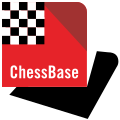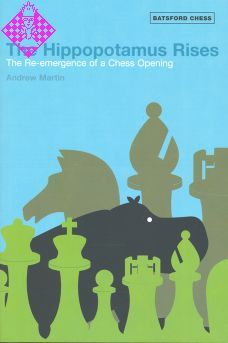Article Number
LOMARTHR
Author
The Hippopotamus Rises
144 pages, paperback, Batsford Chess, 1. edition 2005
Discontinued
In these days of huge databases and long forcing lines, the Hippopotamus chess opening stands out, offering everyone the chance to play chess in an original and interesting way. Black plays his pawns up to the third rank (lying low in the water like the hippopotamus himself), perhaps fianchettos both Bishops and bides his time, waiting for the right moment to strike.
International Master Andrew Martin traces the history of this fascinating line, examines all the critical move-orders, gives recommendations, and shows how this opening is used with success at all levels, from club players to Grandmasters. But perhaps the best thing about the Hippopotamus is that, for once, there is no fixed theory: you can tailor the opening to suit yourself.
International Master Andrew Martin traces the history of this fascinating line, examines all the critical move-orders, gives recommendations, and shows how this opening is used with success at all levels, from club players to Grandmasters. But perhaps the best thing about the Hippopotamus is that, for once, there is no fixed theory: you can tailor the opening to suit yourself.
| EAN | 9780713489897 |
|---|---|
| Weight | 230 g |
| Manufacturer | Batsford Chess |
| Width | 15.6 cm |
| Height | 23.4 cm |
| Medium | Book |
| Year of Publication | 2005 |
| Author | Andrew Martin |
| Language | English |
| Edition | 1 |
| ISBN-10 | 0713489898 |
| ISBN-13 | 9780713489897 |
| Pages | 144 |
| Binding | paperback |
005 Introduction
009 The Modern Approach - and Games Plan
021 Bc4 Systems
037 Austrian Attack
060 Quiet System
082 Systems with an early Be3 or Bg5
099 A Hero of the Hippo
111 Friends of the Hippo
133 Index of Players
137 Index of Variations
009 The Modern Approach - and Games Plan
021 Bc4 Systems
037 Austrian Attack
060 Quiet System
082 Systems with an early Be3 or Bg5
099 A Hero of the Hippo
111 Friends of the Hippo
133 Index of Players
137 Index of Variations
The Hippopotamus is some way related to the double fianchetto where black deploys his bishops on b7 and g7.
Original the Hippopotamus was an invention from the excentric chess player Thompson who played it like this: 1.d4 g6 2.c4 f6 3.Nc3 Nh6 4.Nf3 Nf7 5.Bf4 e6 6.e4 d6 7.Bd3 c6 8.0-0 Be7 and even wrote a book about it!
But IM Andrew Martin brings the Hippopotamus in this book to life with a more modern approach and learns the reader at the hand of a collection of instructive games how and when to strike back from his cramped but not compromised position.
A nice example of play is the game between Spoelman and Hort from the EssentOpen,Hoogeveen 2002: 1.e4 g6 2.d4 d6 3.Be3 Bg7 4.Nc3 a6 5.a4 b6 6.Qd2 Bb7 7.Bc4 Nd7 8.Nf3 e6 9.0-0 h6 10.Rfe1 Ne7 11.Rad1 Kf8 12.Bd3 Kg8 13.Ne2 Nf6 14.Ng3 Qe8 15.Qb4 a5 16.Qa3 Rd8 17.c4 Nd7 18.h4 Nc6 19.Bb1 Nb4 20.b3 e5 21.dxe5 dxe5 22.Qc1 Qe7 23.Rd2 Kh7 24.Red1 Na6 25.Ne2 Ndc5 26.Nc3 Nxb3 27.Rxd8 Nxc1 28.R8d7 Qe6 29.Bxc1 Bc6 30.R7d3 Nb4 31.R3d2 Qxc4 32.Bb2 Re8 33.Rc1 Qe6 34.Ba3 Re7 35.Nd5 Bxd5 36.exd5 Qg4 37.d6 cxd6 38.Rxd6 e4 39.Nh2 Qxh4 40.Rxb6 Bd4 0-1
The author writes instructively; a remarkable little game which should really have been concluded 15 moves ago. White’s intitial advantage in space and time seemed to evaporate and he was left only with weaknesses. Spoelman was doubles baffled - where on earth did he go wrong? {17.c4? was a horrible move! Please see Tiger’s Modern!}
Creeping around the edges in the Hippopotamus but as Tiger Hillarp Persson described it in his Tiger’s Modern the Hippo lies low in the water. It looks almost ridiculously passive and many theoreticians consider the hippo to be a peaceful almost meek animal. But nothing could be further from the truth!
Very interesting in this book is the chapter Friends of the Hippo where Andrew Martin digs in some exciting sub lines of the Hippo which you normally only see in obscure gambit magazines as 1.e4 b6 2.d4 Bb7 3.Bd3 g6 4.f4 f5!?
A hero of the Hippopotamus was Dr.Max Ujtelky who blazed the next generation with his wacky ideas.{A Martin}
Conclusion: A very creative written openings book!
With kind permission of the author John Elburg (www.chessbooks.nl)
Original the Hippopotamus was an invention from the excentric chess player Thompson who played it like this: 1.d4 g6 2.c4 f6 3.Nc3 Nh6 4.Nf3 Nf7 5.Bf4 e6 6.e4 d6 7.Bd3 c6 8.0-0 Be7 and even wrote a book about it!
But IM Andrew Martin brings the Hippopotamus in this book to life with a more modern approach and learns the reader at the hand of a collection of instructive games how and when to strike back from his cramped but not compromised position.
A nice example of play is the game between Spoelman and Hort from the EssentOpen,Hoogeveen 2002: 1.e4 g6 2.d4 d6 3.Be3 Bg7 4.Nc3 a6 5.a4 b6 6.Qd2 Bb7 7.Bc4 Nd7 8.Nf3 e6 9.0-0 h6 10.Rfe1 Ne7 11.Rad1 Kf8 12.Bd3 Kg8 13.Ne2 Nf6 14.Ng3 Qe8 15.Qb4 a5 16.Qa3 Rd8 17.c4 Nd7 18.h4 Nc6 19.Bb1 Nb4 20.b3 e5 21.dxe5 dxe5 22.Qc1 Qe7 23.Rd2 Kh7 24.Red1 Na6 25.Ne2 Ndc5 26.Nc3 Nxb3 27.Rxd8 Nxc1 28.R8d7 Qe6 29.Bxc1 Bc6 30.R7d3 Nb4 31.R3d2 Qxc4 32.Bb2 Re8 33.Rc1 Qe6 34.Ba3 Re7 35.Nd5 Bxd5 36.exd5 Qg4 37.d6 cxd6 38.Rxd6 e4 39.Nh2 Qxh4 40.Rxb6 Bd4 0-1
The author writes instructively; a remarkable little game which should really have been concluded 15 moves ago. White’s intitial advantage in space and time seemed to evaporate and he was left only with weaknesses. Spoelman was doubles baffled - where on earth did he go wrong? {17.c4? was a horrible move! Please see Tiger’s Modern!}
Creeping around the edges in the Hippopotamus but as Tiger Hillarp Persson described it in his Tiger’s Modern the Hippo lies low in the water. It looks almost ridiculously passive and many theoreticians consider the hippo to be a peaceful almost meek animal. But nothing could be further from the truth!
Very interesting in this book is the chapter Friends of the Hippo where Andrew Martin digs in some exciting sub lines of the Hippo which you normally only see in obscure gambit magazines as 1.e4 b6 2.d4 Bb7 3.Bd3 g6 4.f4 f5!?
A hero of the Hippopotamus was Dr.Max Ujtelky who blazed the next generation with his wacky ideas.{A Martin}
Conclusion: A very creative written openings book!
With kind permission of the author John Elburg (www.chessbooks.nl)
The Hippopotamus is some way related to the double fianchetto where black deploys his bishops on b7 and g7.
Original the Hippopotamus was an invention from the excentric chess player Thompson who played it like this: 1.d4 g6 2.c4 f6 3.Nc3 Nh6 4.Nf3 Nf7 5.Bf4 e6 6.e4 d6 7.Bd3 c6 8.0-0 Be7 and even wrote a book about it!
But IM Andrew Martin brings the Hippopotamus in this book to life with a more modern approach and learns the reader at the hand of a collection of instructive games how and when to strike back from his cramped but not compromised position.
A nice example of play is the game between Spoelman and Hort from the EssentOpen,Hoogeveen 2002: 1.e4 g6 2.d4 d6 3.Be3 Bg7 4.Nc3 a6 5.a4 b6 6.Qd2 Bb7 7.Bc4 Nd7 8.Nf3 e6 9.0-0 h6 10.Rfe1 Ne7 11.Rad1 Kf8 12.Bd3 Kg8 13.Ne2 Nf6 14.Ng3 Qe8 15.Qb4 a5 16.Qa3 Rd8 17.c4 Nd7 18.h4 Nc6 19.Bb1 Nb4 20.b3 e5 21.dxe5 dxe5 22.Qc1 Qe7 23.Rd2 Kh7 24.Red1 Na6 25.Ne2 Ndc5 26.Nc3 Nxb3 27.Rxd8 Nxc1 28.R8d7 Qe6 29.Bxc1 Bc6 30.R7d3 Nb4 31.R3d2 Qxc4 32.Bb2 Re8 33.Rc1 Qe6 34.Ba3 Re7 35.Nd5 Bxd5 36.exd5 Qg4 37.d6 cxd6 38.Rxd6 e4 39.Nh2 Qxh4 40.Rxb6 Bd4 0-1
The author writes instructively; a remarkable little game which should really have been concluded 15 moves ago. White’s intitial advantage in space and time seemed to evaporate and he was left only with weaknesses. Spoelman was doubles baffled - where on earth did he go wrong? {17.c4? was a horrible move! Please see Tiger’s Modern!}
Creeping around the edges in the Hippopotamus but as Tiger Hillarp Persson described it in his Tiger’s Modern the Hippo lies low in the water. It looks almost ridiculously passive and many theoreticians consider the hippo to be a peaceful almost meek animal. But nothing could be further from the truth!
Very interesting in this book is the chapter Friends of the Hippo where Andrew Martin digs in some exciting sub lines of the Hippo which you normally only see in obscure gambit magazines as 1.e4 b6 2.d4 Bb7 3.Bd3 g6 4.f4 f5!?
A hero of the Hippopotamus was Dr.Max Ujtelky who blazed the next generation with his wacky ideas.{A Martin}
Conclusion: A very creative written openings book!
With kind permission of the author John Elburg (www.chessbooks.nl)
Original the Hippopotamus was an invention from the excentric chess player Thompson who played it like this: 1.d4 g6 2.c4 f6 3.Nc3 Nh6 4.Nf3 Nf7 5.Bf4 e6 6.e4 d6 7.Bd3 c6 8.0-0 Be7 and even wrote a book about it!
But IM Andrew Martin brings the Hippopotamus in this book to life with a more modern approach and learns the reader at the hand of a collection of instructive games how and when to strike back from his cramped but not compromised position.
A nice example of play is the game between Spoelman and Hort from the EssentOpen,Hoogeveen 2002: 1.e4 g6 2.d4 d6 3.Be3 Bg7 4.Nc3 a6 5.a4 b6 6.Qd2 Bb7 7.Bc4 Nd7 8.Nf3 e6 9.0-0 h6 10.Rfe1 Ne7 11.Rad1 Kf8 12.Bd3 Kg8 13.Ne2 Nf6 14.Ng3 Qe8 15.Qb4 a5 16.Qa3 Rd8 17.c4 Nd7 18.h4 Nc6 19.Bb1 Nb4 20.b3 e5 21.dxe5 dxe5 22.Qc1 Qe7 23.Rd2 Kh7 24.Red1 Na6 25.Ne2 Ndc5 26.Nc3 Nxb3 27.Rxd8 Nxc1 28.R8d7 Qe6 29.Bxc1 Bc6 30.R7d3 Nb4 31.R3d2 Qxc4 32.Bb2 Re8 33.Rc1 Qe6 34.Ba3 Re7 35.Nd5 Bxd5 36.exd5 Qg4 37.d6 cxd6 38.Rxd6 e4 39.Nh2 Qxh4 40.Rxb6 Bd4 0-1
The author writes instructively; a remarkable little game which should really have been concluded 15 moves ago. White’s intitial advantage in space and time seemed to evaporate and he was left only with weaknesses. Spoelman was doubles baffled - where on earth did he go wrong? {17.c4? was a horrible move! Please see Tiger’s Modern!}
Creeping around the edges in the Hippopotamus but as Tiger Hillarp Persson described it in his Tiger’s Modern the Hippo lies low in the water. It looks almost ridiculously passive and many theoreticians consider the hippo to be a peaceful almost meek animal. But nothing could be further from the truth!
Very interesting in this book is the chapter Friends of the Hippo where Andrew Martin digs in some exciting sub lines of the Hippo which you normally only see in obscure gambit magazines as 1.e4 b6 2.d4 Bb7 3.Bd3 g6 4.f4 f5!?
A hero of the Hippopotamus was Dr.Max Ujtelky who blazed the next generation with his wacky ideas.{A Martin}
Conclusion: A very creative written openings book!
With kind permission of the author John Elburg (www.chessbooks.nl)


